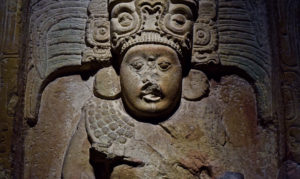
It was fitting that her ashes found their final resting place in this place. Set high on the summit within the jungle-choked ruins of the ancient Maya acropolis of Piedras Negras in Guatemala, a small, simple, rectangular grave stone marks an almost wordless epitaph — only her name and the years that defined her birth and death are inscribed upon the marker. In life, those who knew her well called her simply ‘Tania’. But in death, written history best knows her as Tatiana Proskouriakoff, and it was here, in Piedras Negras, where her legacy really began.
Tatiana was born a world away from Piedras Negras in Tomsk, Russia, to a physician mother, Alia Nekrassova, and chemist and engineer father, Avenir Proskouriakoff. Her family moved to Ohio when she was only five years old. It was 1916, and by then the world had already erupted into war, her father having been tasked to oversee production of munitions for the Russian war effort. Plans were to return to Russia after his assignment. It seemed world events had other plans for this family, however. The Russian Revolution in 1917, which saw the end of Avenir’s Tsarist overseers, sealed the family’s fate in the United States. They were never to permanently return. Tatiana became an American.
In the early years, her parents must have been clueless about her developing gifts until she demonstrated a remarkable proficiency to read at age 3 and showed an unusual talent for drawing. Her brilliance flourished after moving to Lansdowne, Pennsylvania, after which she graduated valedictorian of her high school class. But it was her drawing talent and education in architecture at the Pennsylvania State College School of Architecture a few years later that set the stage in launching a career of achievements that would revolutionize our understanding of one of the world’s greatest civilizations — the ancient Maya.
Revelations along the Usumacinta
Graduation from college came just in time for the devastation of the Great Depression, forcing Tatiana, like so many others in those times, to place her dreams on hold. A career in architecture had to wait. But, as the adage goes, where doors close, new windows open, and she took an opportunity to volunteer for the Classics Department of the University of Pennsylvania as a volunteer, producing archaeological illustrations. Her artistic excellence and architectural rendering caught the eye of Linton Satterthwaite, then the Assistant Curator of the American Section at the University of Pennsylvania Museum of Archaeology and Anthropology (henceforth in this writing — the Museum, popularly known today as the Penn Museum). He knew she was fascinated with the archaeological exhibits at the Museum. Why not have her join the University’s ongoing excavations at Piedras Negras, a project also under Satterthwaite’s direction, to do architectural drawings of the monumental remains? Satterthwaite likely anticipated what Tatiana’s response to the offering would be — 1936, and it was off to the jungles of Guatemala.

Tatiana Proskouriakoff, the expedition architect for Piedras Negras in 1936. Penn Museum image #37401.
Piedras Negras hugs the eastern banks of the Usumacinta River, which forms a natural border between Mexico and Guatemala. Anciently, the river served as the vital lifeblood for Maya centers built near or along its route, not only as a source of water but also as an important trade route of goods between centers. Among the settlements were Yaxchilan and Piedras Negras, two of the most powerful cities of the Maya Classic Period. Situated high on the north bank of the river in northeastern Guatemala, Piedras Negras (anciently called Yo’k’ib’ or ‘great gateway’), was occupied since the 7th century BCE with a Late Preclassic period peak in about 200 BCE and another great florescence during the Late Classic period. It became the focus of extensive excavations by the Museum beginning in 1931.
Tatianna arrived at the site just three years before the Museum excavations closed, and by then the site had already revealed its distinctive character as a massive center featuring numerous beautifully sculpted stelae and hieroglyphic inscriptions. She soon demonstrated her remarkable gift for rendering the ancient architecture at the site, particularly her unique ability to visualize, based on analysis of the remains, how the structures would have appeared in their complete, reconstructed state.
____________________________
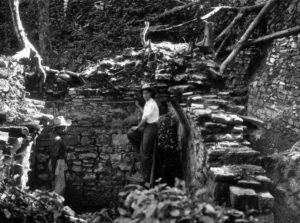
Tatiana Proskouriakoff worked extensively at Piedras Negras. Courtesy University of Pennsylvania Museum of Archaeology and Anthropology
____________________________
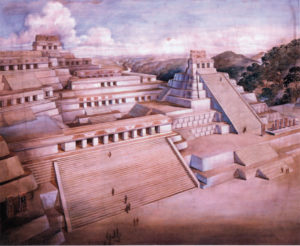
“The acropolis at Piedras Negras. Restored view.” Watercolor by Tatiana Proskouriakoff, 1939. UPM neg. T4-206″. Courtesy University of Pennsylvania Museum of Archaeology and Anthropology
____________________________
Notwithstanding her significant contributions to the visualization of Maya monumental architecture, it was actually years later when she made the discovery that arguably defined her greatest contribution to Maya research and archaeology. During the late 1950’s she returned to the Piedras Negras monumental record again to study the Maya glyphs that adorned the many stelae discovered at the site. Her previous work at other sites, especially Copán and its famous Hieroglyphic Stairway, led her to formulate a compelling new question: Do the glyphs that so copiously illustrate Maya monuments actually represent Maya history and its rulers, and not religious or priestly matters, as the prevailing thought among scholars at the time suggested? The numerous beautifully carved stelae with their prolific range of glyphs at Piedras Negras provided a perfect test case for research. Tatiana went to work. Focusing on the inscriptions, she observed certain glyph repetitions or patterns common to all monuments. She eventually determined that some glyphs must have stood for birth and others for death, and yet others represented the names of rulers, lineage, capture of enemies, and other events and characteristics of Maya rulers. In other words, her earlier hypothesis gleaned from her study of the Hieroglyphic Stairway at Copán was confirmed — the inscriptions on the monuments represented the actual history, in this case, of Piedras Negras.
 Tatiana’s finding was a game-changer for understanding the Maya. “In Tatiana’s day, people believed Maya cities weren’t really cities,” says Simon Martin, currently Associate Curator and Keeper of Collections in the American Section of the Penn Museum. “They were [considered to be] ceremonial centers ruled by priests. It was thought that the population didn’t live in the centers. They were scattered around in the forest, and they might have just gathered together [in the centers] for ceremonies and rituals.” Martin points to a key monument designated as “Stela 14”, now housed and on display in the Museum’s newly opened Mexico and Central America Gallery. It once resided with 39 other stelae at Piedras Negras. “The figures on Stela 14 were originally thought to be a god and then [depicted] down below a priest, who is making offerings toward her [see image right]” But at Piedras Negras, says Martin, “Tatiana started working on chronology and the relationship between particular dates and particular images on the monuments”. Referring to Stela 14, Martin says that Tatiana was able to recognize or identify a glyph inscribed with a series or column of glyphs on the side of the stela as an “event glyph”, which signified the occurrence of a very significant event in the Maya chronology of the site. “She hypothesized that this event glyph referred to someone becoming a king, which turned out to be completely correct. Thanks to Tatiana’s work, we realize that the seated figure is a king, and the one standing below is a queen.” Many Maya hieroglyphs, it turned out, were actually a record of the kings and queens and the associated events of their times. And more than that, Tatiana’s work was ultimately a key to deciphering the Maya script, something that had eluded scientists and scholars for years. Stela 14, and the other stelae discovered and studied at Piedras Negras, acted like a ‘Rosetta Stone’ for translating ancient Maya history and culture.
Tatiana’s finding was a game-changer for understanding the Maya. “In Tatiana’s day, people believed Maya cities weren’t really cities,” says Simon Martin, currently Associate Curator and Keeper of Collections in the American Section of the Penn Museum. “They were [considered to be] ceremonial centers ruled by priests. It was thought that the population didn’t live in the centers. They were scattered around in the forest, and they might have just gathered together [in the centers] for ceremonies and rituals.” Martin points to a key monument designated as “Stela 14”, now housed and on display in the Museum’s newly opened Mexico and Central America Gallery. It once resided with 39 other stelae at Piedras Negras. “The figures on Stela 14 were originally thought to be a god and then [depicted] down below a priest, who is making offerings toward her [see image right]” But at Piedras Negras, says Martin, “Tatiana started working on chronology and the relationship between particular dates and particular images on the monuments”. Referring to Stela 14, Martin says that Tatiana was able to recognize or identify a glyph inscribed with a series or column of glyphs on the side of the stela as an “event glyph”, which signified the occurrence of a very significant event in the Maya chronology of the site. “She hypothesized that this event glyph referred to someone becoming a king, which turned out to be completely correct. Thanks to Tatiana’s work, we realize that the seated figure is a king, and the one standing below is a queen.” Many Maya hieroglyphs, it turned out, were actually a record of the kings and queens and the associated events of their times. And more than that, Tatiana’s work was ultimately a key to deciphering the Maya script, something that had eluded scientists and scholars for years. Stela 14, and the other stelae discovered and studied at Piedras Negras, acted like a ‘Rosetta Stone’ for translating ancient Maya history and culture.
___________________________
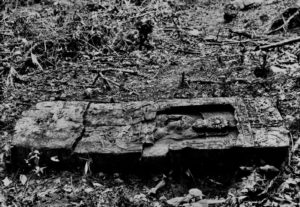
Stela 14 at Piedras Negras. Courtesy University of Pennsylvania Museum of Archaeology and Anthropology
___________________________
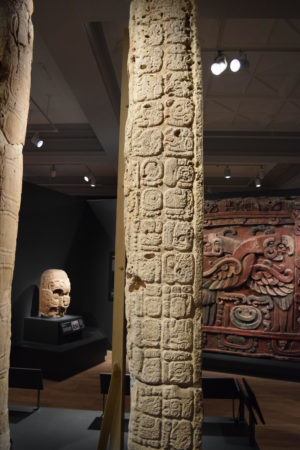
Glyph column along the left side edge of Stela 14, shown in foreground of exhibit space at the Penn Museum.
___________________________

Detail of the glyph column. The glyph at the bottom right is the ‘event glyph’ identified by Tatiana Proskouriakoff.
___________________________
Bringing the Ancient Maya to Our Back Yard
As was common among university museum-led archaeological expeditions of the time, a number of monuments excavated at Piedras Negras were borrowed and transported to the Penn Museum for exhibition and further study. Most of those monuments were returned to Guatemala in 1947, but today two objects, the aforementioned famous Stela 14 and a leg support for Altar 4, remain at the Museum and are now on display in the new Mexico and Central America Gallery.
The Penn Museum boasts “the largest collection of Maya stelae than anywhere outside of Mexico or central America,” says Martin. Those stelae now grace the exhibit space of the new gallery, including Stela 14. While the gallery is the largest exhibit of Maya stone monuments in the United States, it also makes clear that there was much more to ancient Central America than the Maya, and it displays this in a well-appointed array of select artifacts and other objects, organized by the various ancient cultures that defined this region of the world for centuries, such as the Olmec, Teotihuacán, the Aztec, and others. Martin’s hand is reflected in the displays. As an epigrapher, he has been actively engaged in research related to the continuing efforts to unlock the meaning of the Maya script and what they say about the story and culture of the ancient Maya. “Scholars today are moving on from Tatiana’s insights,” he says. Although much if not most of the script can now be deciphered, “we’re [still] trying to understand how the language was structured. We’re trying to decipher some of the unknown signs, and, more importantly, we’re trying to put it all together to understand ancient Maya society.” But time has unfortunately also taken its toll on recovered remains, frustrating scholarly efforts. “Stela 14 once had a longer text, but that is now eroded away,” laments Martin. “It would be useful to know a bit more about this ruler, but Stela 14 itself can be no further help.” In addition to understanding this ancient culture, Martin is also hoping the ongoing decipherment of the Maya glyphs may shed some light on when and, especially, why, the Classic period monumental civilization that characterized the southern lowlands of the Maya so precipitously declined and ‘collapsed’ between the 8th and 9th centuries. Some of the artifacts therefor reflect the end of this Classic period. “My challenge at the moment is to understand the ninth century texts and see what they can tell us about the collapse,” wrote Martin to Popular Archaeology. Martin’s study of Caracol Altar 13, for example, now a part of the new gallery exhibit, has been part of his efforts (see below).
For anyone interested in the ancient civilizations of this region, the new gallery is a must-see. But it is also worth noting that it represents only a tiny percentage of the artifacts and monuments discovered and still undiscovered related to this region—a visible reminder of how much we know about these monumental cultures, and how much we still don’t.
_________________________
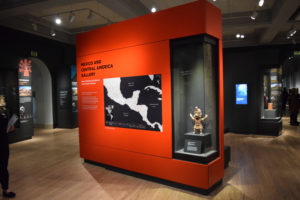
The view as one enters the new Mexico and Central America gallery at the Penn Museum.
_________________________
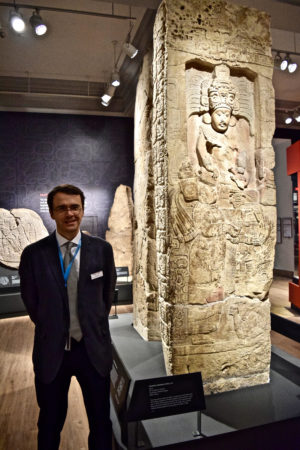
Simon Martin with Stela 14 at the new Penn Museum Mexico and Central America gallery.
_________________________
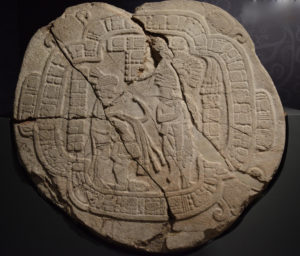
Caracol Altar 13, now exhibited at the Penn Museum’s Mexico and Central America Gallery. Martin is studying monumental remains like this with the hope of shedding new light on the political dynamics of 9th century Maya civilization. This altar depicts interaction between two figures, both presumably kings or royal figures, but from different cities. “The two characters,” explains Martin, “are twice linked in the text by the term ‘yichonal’, which means “before” or better “in his sight”. Everywhere we see that between two people it denotes that the first person is “overseen” by the second. The left-hand figure, Papmalil, is ascribed the ‘ochk’in kaloomte’ title, which denotes an especially high rank over that of a standard king. Papmalil is mentioned three times on the monument—an unprecedented emphasis for a visitor—while the local king is named only twice.” Martin is not certain where the scene is taking place. It may not be at Caracol but at Ucanal (the left-hand figure’s city) instead, meaning that K’inich Toobil Yopaat (the king of Caracol) may actually be the visitor.
_________________________
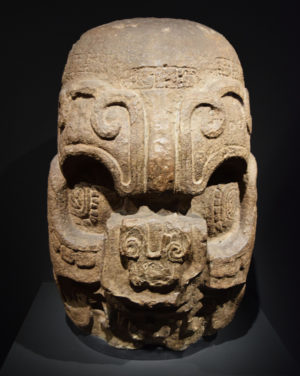
One of four support stones for Piedras Negras Altar 4 (see below), as exhibited at the new Penn Museum gallery. Dated to 790 CE. For ancient Maya people, stone was not lifeless rock but a living thing. They believed that sculptures were infused by an animating spirit or force.
_________________________
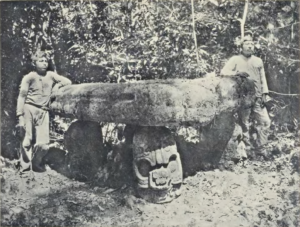
_________________________
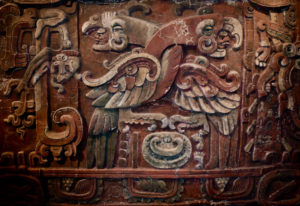
As exhibited in the Penn Museum gallery, a replica of the ‘Margarita Panel’, part of the 450 CE temple facade in Copan, Honduras. It was discovered by Penn Museum archaeologists in 1992. The temple shrine was found by deep tunneling through the city’s main acropolis.
_________________________
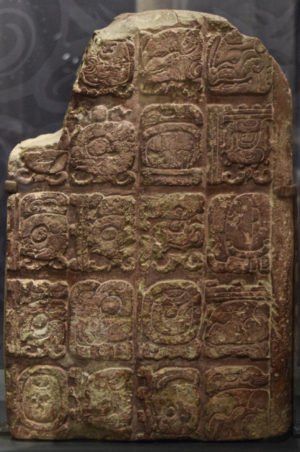
Fragment of a stela, exhibited at the new Penn Museum gallery. Stone, 600 – 800 CE. The inscription includes a very large number counting up to 43 million years from a date in the mythological past to another date in the Classic Period.
_________________________
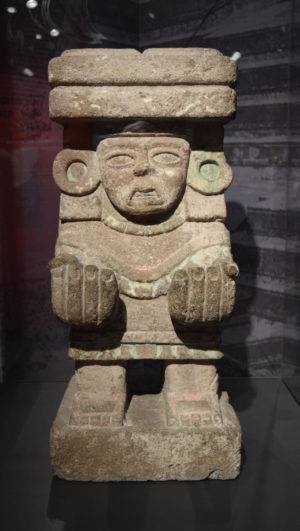
Statue of Water Goddess of the Teotihuacan culture, exhibited at the new Penn Museum gallery. Stone, 100 – 550 CE, Teotihuacan. The Water Goddess was a deity of fertility and abundance.
_________________________
Readers can read more about the Mexico and Central America Gallery here.
_________________________
About the Penn Museum
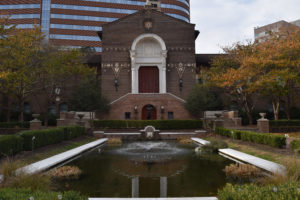 The Penn Museum (the University of Pennsylvania Museum of Archaeology and Anthropology) is dedicated to the study and understanding of human history and diversity. Founded in 1887, the Museum has sent more than 300 archaeological and anthropological expeditions to all the inhabited continents of the world. With an active exhibition schedule and educational programming for children and adults, the Museum offers the public an opportunity to share in the ongoing discovery of humankind’s collective heritage.
The Penn Museum (the University of Pennsylvania Museum of Archaeology and Anthropology) is dedicated to the study and understanding of human history and diversity. Founded in 1887, the Museum has sent more than 300 archaeological and anthropological expeditions to all the inhabited continents of the world. With an active exhibition schedule and educational programming for children and adults, the Museum offers the public an opportunity to share in the ongoing discovery of humankind’s collective heritage.
The Penn Museum is located at 3260 South Street, Philadelphia, PA 19104 (on Penn’s campus, across from Franklin Field). Public transportation to the Museum is available via SEPTA’s Regional Rail Line at University City Station; the Market-Frankford Subway Line at 34th Street Station; trolley routes 11, 13, 34, and 36; and bus routes 21, 30, 40, and 42. Museum hours are Tuesday through Sunday, 10:00 am to 5:00 pm, and first Wednesdays of each month until 8:00 pm. Open select holiday Mondays. Museum admission donation is $15 for adults; $13 for senior citizens (65 and above); free for U.S. Military; $10 for children and full-time students with ID; free to Penn Museum Members, PennCard holders, and children 5 and younger.
____________________________
Advertisement



